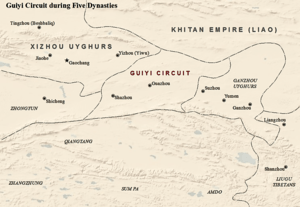Xiliangfu
| Xiliangfu | |||||||||
|---|---|---|---|---|---|---|---|---|---|
| 906–1016 | |||||||||
 | |||||||||
| Status | Tribal Confederation | ||||||||
| Capital | Liangzhou (modern Wuwei) | ||||||||
| Common languages | Tibetan | ||||||||
| Religion | Buddhism | ||||||||
| Government | Tribal | ||||||||
| History | |||||||||
• Established | 906 | ||||||||
• Disestablished | 1016 | ||||||||
| |||||||||
Xiliangfu, also known as Liangzhou, Lingchu Serkap, or the Liugu Tibetans, was a Tibetan tribal confederation that ruled modern Wuwei in Gansu Province, China. It gained independence from the Guiyi Circuit in the late 9th century and was conquered by the Tanguts and Uyghurs in 1015 and 1016.[1]
History
In 996 Tanguts began raiding Liangzhou.[2]
In 998 Xiliangfu had a population of 128,000.[3]
In 1001 Panluozhi came to power.[2]
In 1003 Li Jiqian occupied Liangzhou but failed to hold the city when their forces fell to a Tibetan ambush.[2]
In 1004 Panluozhi was assassinated by Tanguts and his brother Siduodu succeeded him.[2]
In 1006 and several following years Liangzhou suffered from plague.[4]
In 1015 Tanguts capture Liangzhou.[5]
In 1016 the Ganzhou Uyghur Kingdom ousted the Tanguts from Liangzhou.[5]
Around 1032 the Tanguts annexed Liangzhou.[6]
References
- ↑ Tuttle 2013, p. xvi.
- 1 2 3 4 Twitchett 1994, p. 172.
- ↑ Tuttle 2013, p. 146.
- ↑ Twitchett 1994, p. 173.
- 1 2 Twitchett 1994, p. 175.
- ↑ Twitchett 1994, p. 176.
Bibliography
- Tuttle, Gray (2013), The Tibetan History Reader, Columbia University Press
- Twitchett, Denis (1994), The Cambridge History of China, Volume 6, Alien Regime and Border States, 907-1368, Cambridge: Cambridge University Press, ISBN 0521243319